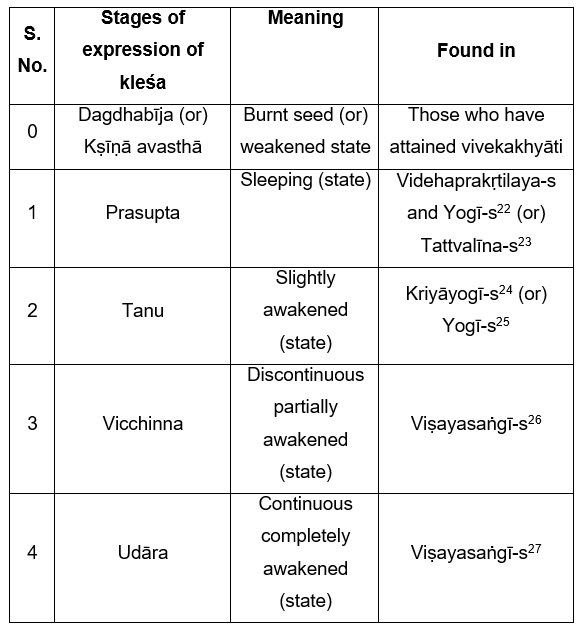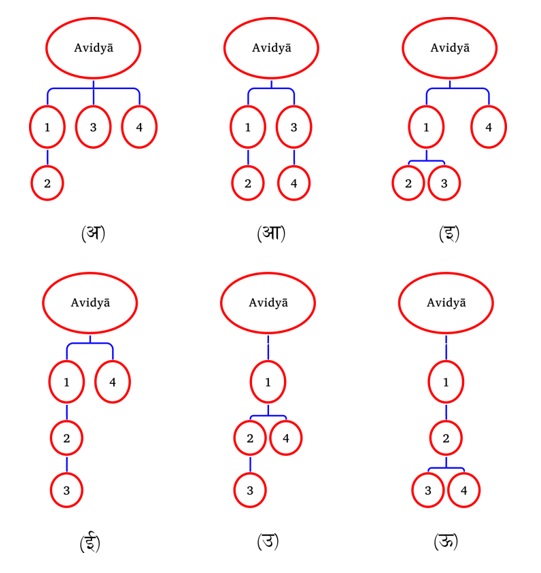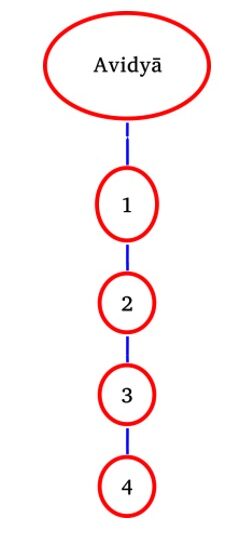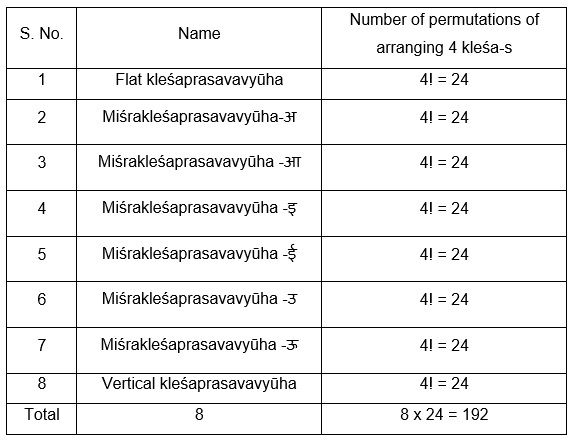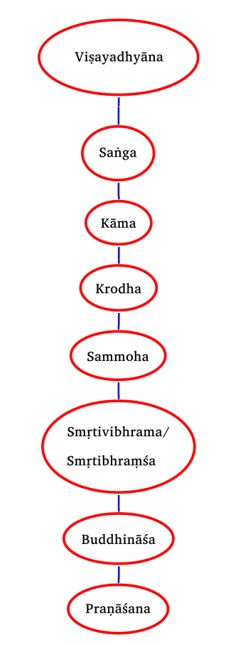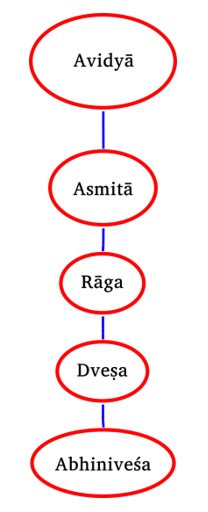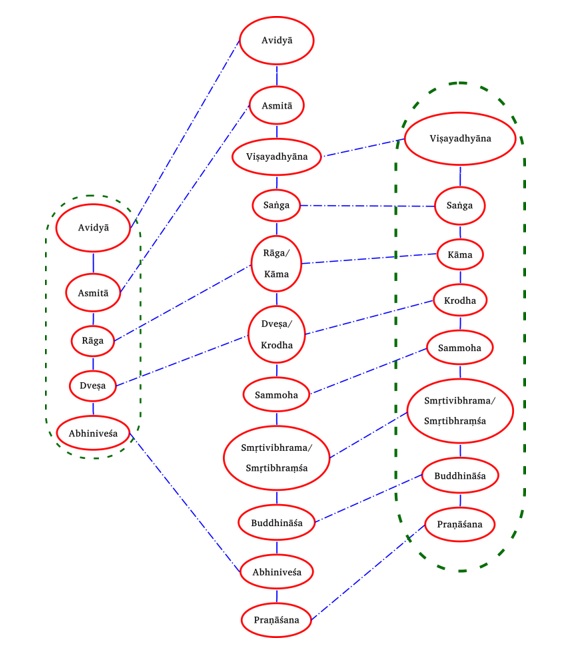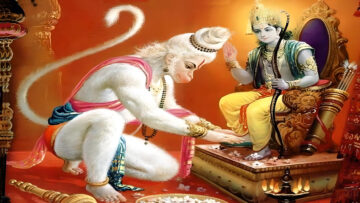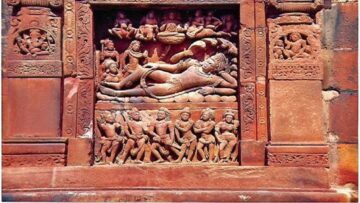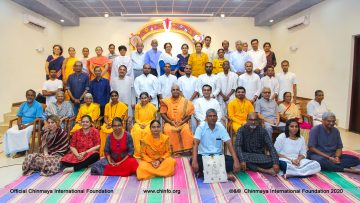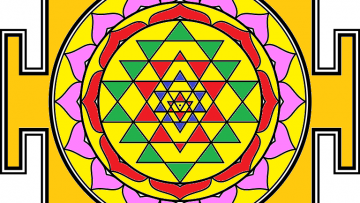Introduction
Maharṣi Patañjali’s Yogasūtra-s
Maharṣi Patañjali’s Yogasūtra-s (PYS), considered the most authoritative pramāṇagrantha of Rājayoga, has four pāda-s as chapters. Each pāda deals with part of a theoretical framework or a specific set of practices meant for sādhaka-s based on their adhikāra. When taken as a whole set of four pāda-s, PYS forms a comprehensive darśana requiring entire lives dedicated to unlocking the different depths and dimensions of the full range of lifelong lessons found hidden in cryptic short sūtra-s[1]. Different vyākhyāna-s[2] to PYS handed down to us over the centuries based on the vyākhyātā-s’[3] anubhava-s in addition to their own pāṇḍitya in Saṃskṛta as well as the modern students’ own anubhava-s and pāṇḍitya make PYS a never ending fountainhead of jñāna.
Samādhipāda
Samādhipāda, the first chapter in PYS, is meant for the most advanced[4] sādhaka and hence, speaks directly about samādhi. Here, it seems that Maharṣi Patañjali presupposes that the sādhaka knows all the basics and is capable of cittavṛttinirodha and is just present to learn the various other dimensions of yoga along the way.
Sādhanapāda
Sādhanapāda, the second chapter in PYS, is meant for other sādhaka-s and starts[5] with the introduction to a specific sādhana called kriyāyoga[6] which is for the intermediate sādhaka[7].
Kriyāyoga
Kriyāyoga is defined[8] as consisting of three specific parts – tapas[9], svādhyāya, and īśvarapraṇidhāna. The next sūtra[10] clarifies the phala of kriyāyoga by stating that when kriyāyoga is practised, samādhi becomes possible[11] because of the kleśa-s becoming smaller, i.e. tanūkaraṇa[12] of kleśa-s.
Kleśa-s
Kleśa-s[13].[14] are then introduced as a list[15],[16] – avidyā, asmitā, rāga, dveṣa, and abhiniveśa. Kleśa-s are essentially causes of duḥkha to the puruṣa (individual consciousness). Each of the kleśa-s are defined following this.
Avidyā
Avidyā is the supporting land (kṣetra) for the other kleśa-s seen in four different stages[17] – prasupta (dormant seed stage which can rise in the presence of supportive elements), tanu (subtle[18] stage where any kleśa is inactivated by pratipakṣabhāvanā[19]), vicchinna (overpowered by any one kleśa which is discontinuous), and udāra (manifested/expressed by the obtained association with objects of kleśa in the presence of supportive conditions[20]).[21] Further these four stages are seen expressed in four different sādhaka-s. One preceding stage, where the kleśa is at minimal activation, is also indicated in the table (Table 1) below based on the commentaries.
(Table 1: Five Stages of expression of kleśa-s)
There is consensus in the commentaries that avidyā gives birth[28] to the other kleśa-s.
Avidyā is then immediately defined[29] as seeing/knowing/perceiving that which is impermanent (anitya), unclean (aśuci), suffering (duḥkha) and non-Self (anātmā) as permanent (nitya), clean (śuci), pleasant (sukha) and Self (ātmā).[30]
Asmitā
Asmitā is defined[31] as the (wrong perception[32] of) semblance of the capacity[33] of the observer (puruṣa[34] or draṣṭā[35]) and the capacity[36] of the observed (buddhi[37], sāttvikapariṇāma of the antaḥkaraṇa[38], or pradhāna[39]).
Rāga
Rāga is defined[40] as the attachment to (or exclusive attention to[41]) sukha[42] (pleasure).
Dveṣa
Dveṣa is defined[43] as the anger against (or exclusive aversion to) duḥkha[44] (suffering).
Abhiniveśa
Abhiniveśa is defined[45] as that[46] which flows[47] from one’s own saṃskāra-s (impressions) and arises/becomes significant even in the wise.
Pratiprasava
The next sūtra[48] states[49] that those (kleśa-s) which have been rendered subtle have to be removed[50] by going against the process of prasava.
Śrīmadbhagavadgītā
The Śrīmadbhagavadgītā (BG) is found in the Bhīṣmaparva of the Mahābhārata where we find the major portion dealing with bhagavān Śrīkṛṣṇa expounding many lessons to Arjuna on the battlefield at Kurukṣetra. These lessons, though generally assumed to be regarding mokṣa, also talk about psychological aspects dealing with manas, buddhi, citta, and ahaṃkāra as well as certain pertinent observations on underlying psychological processes, ultimate goals, and useable methods. The numerous commentaries[51] to BG explain the lessons with more clarity.
Doṣa-s
The sixty second[52] and sixty third[53] śloka-s in the second adhyāya briefly touch upon the process [54], [55], [56], [57] of how after an object (viṣaya) (that is part of the ephemeral Universe) has been dwelt upon (dhyāyan) by the mind[58], there is association (saṅga) of the mind with the object. This association eventually leads to the mind to desire (kāma) the object or at least proximity to it. When there is separation from the object there is anger (krodha). This anger leads to delusion/confusion in understanding (saṃmoha). This further leads to distortion in memory (smṛtivibhrama/smṛtibhraṃśa). This leads to the destruction of the intellect (buddhināśa). Those with a destroyed intellect eventually reach (complete) destruction (praṇāśana). These eight, or rather the seven before praṇāśana may be called doṣa-s[59].
The Prasavavyūha
The aforementioned five-fold kleśaprasavavyūha of PYS and the seven-stepped doṣaprasavavyūha in the BG are similar in succinctly describing a prasavavyūha in/of the mental faculty. Though PYS here talks exclusively of the citta and BG of the manas, we see that they are both referring to similar prasavavyūha-s. The terms janaka and janya are used below to indicate the parent/generator and child/generated concept respectively because of the janaka-janya relationship between different levels observed in any generational model. Let us look at these two generational models sequentially.
Kleśaprasavavyūha in PYS
Based on the information gleaned from PYS II.1-10 and a few of its commentaries, we may construct a kleśaprasavavyūha.
The word avidyāsmitārāgadveṣābhiniveśāḥ in PYS II.3 is a product of itaretaradvandvasamāsa[60] where multiple different objects are separated by the conjunction ca.[61] In this samāsa, it is clear from the Kāśikāvṛtti (KV) to Pāṇini’s Aṣṭādhyāyī (PA) (2.2.34) that the order of enumeration either represents the (descending) order of importance (abhyarhitattva)[62] or the order of generation (ānupūrvyatā)[63]. However, PYS II.3-10 nor its commentaries (used here) speak of this order explicitly. Hence, clarification is wanting.
Thus, what is clear from PYS and its commentaries used here regarding the prasavavyūha is that –
- Avidyā is the first kleśa
- Avidyā gives birth to the other kleśa-s i.e., avidyā is the first janaka and the other kleśa-s are successive janya-s from avidyā
However, it is not clear from PYS II.3-10 nor its commentaries used here whether –
- prasava happens in sequential, parallel, or mixed order
- janya-s are generated from single immediate janaka or multiple immediate janaka-s
This leaves us with the following given –
- the first janaka is avidyā and the chronology of other janya-s are not clear.
- Each janaka may have single or multiple immediate janya-s.
- Each janya may have single or multiple immediate janaka-s.
For the sake of simplicity, let us first consider just one single janaka for each janya and replace the four kleśa-s with numbers (for ease of enumeration and not necessarily indicators of chronology in prasava). This leaves us with 8 different prasava models as shown below –
Flat Kleśaprasavavyūha
In this vyūha, all the janya-s share a horizontal relationship with each other as they all have the same janaka. (See Figure 1)
(Figure 1: The flat kleśaprasavavyūha from PYS)
Miśra- kleśaprasavavyūha-s
In the miśraprasavavyūha-s, the janya-s may either be directly born out of Avidyā or from other janya-s. (See Figure 2)
(Figure 2: The miśra-kleśaprasavavyūha-s (of kleśa-s) from PYS)
Vertical kleśaprasavavyūha
In this vyūha, all the janya-s have one janaka each and hence share a vertical relationship with each other. (See Figure 3)
(Figure 3: The vertical kleśaprasavavyūha from PYS)
Each of these vyūha-s has many permutations in terms of arranging 4 kleśa-s in 4 different positions within a vyūha keeping the first kleśa alone as fixed. This gives us the following information –
(Table 2: Permutations in terms of arranging 4 kleśa-s in 4 different positions within a vyūha)
Thus, we see that just considering one janaka for each janya gives rise to 192 permutations in 8 kleśaprasavavyūha-s. The confusion will be compounded if we consider multiple janaka-s for each janya. As a perfect prasavavyūha is necessary for any sādhaka in rājayoga, a clarification is required regarding the correct kleśaprasavavyūha from PYS.
Doṣaprasavavyūha in BG
Based on the information gleaned from BG 2.62-63 and a few of its commentaries, we may construct a doṣaprasavavyūha.
What is clear from the BG and its commentaries used here regarding the prasavavyūha is that –
- Dwelling on a (wrong) viṣaya is the first doṣa
- Dwelling on a (wrong) viṣaya successively sequentially gives birth to the other doṣa-s i.e., viṣayadhyāna is the first janaka and the other doṣa-s are successive janya-s from viṣayadhyāna (because of the use of the pañcamīvibhaktipratyaya clearly indicating apādāna)
There is no ambiguity here as found in the kleśaprasavavyūha from PYS II.3.
This leaves us with the following given –
- The first janaka is viṣayadhyāna and the chronology of other janya-s is clear.
- Each janaka has a single immediate janya.
- Each janya has a single immediate janaka.
As the sequence is clear, there is no need to number and analyse the permutations possible in the doṣaprasavavyūha in BG. This gives us a completely vertical doṣaprasavavyūha. (See Figure 4)
(Figure 4: The vertical doṣaprasavavyūha from BG)
Saṅkīrṇaprasavavyūha
Having seen both kleśaprasavavyūha and doṣaprasavavyūha, it becomes interesting to combine elements of both these vyūha-s to see a bigger and a more comprehensive hybrid model for generation i.e., saṅkīrṇaprasavavyūha. Wrong understanding is avidyā (PYS). This leads to assuming a false unity i.e., asmitā (PYS). This leads to constantly paying attention to objects of the ephemeral Universe i.e., viṣayadhyāna (BG). This leads to an association, saṅga (BG). This leads to a desire i.e., rāga (PYS) or kāma (BG)[64]. The inability to attain, obtain, or sustain the object of desire leads to anger, called dveṣa (PYS) or krodha (BG)[65]. This leads to confusion in understanding i.e., sammoha (BG). This leads to distortion in memory i.e., smṛtivibhrama/smṛtibhraṃśa (BG). This leads to destruction of the intellect i.e., buddhināśa (BG). This eventually leads to complete destruction i.e., praṇāśana (BG). But prior to the final step, the realization of the destruction leads to fear i.e., abhiniveśa (PYS) (of praṇāśana).
This confirms that the vertical kleśaprasavavyūha from PYS is the best fit when taken alongside doṣaprasavavyūha from BG as a reference. (See Figure 5)
Figure 5: The vertical kleśaprasavavyūha from PYS
Thus, combining elements of kleśaprasavavyūha from PYS and doṣaprasavavyūha from BG we get a saṅkīrṇaprasavavyūha. (See Figure 6)
(Figure 6: The saṅkīrṇaprasavavyūha combining kleśaprasavavyūha from PYS (LHS) and doṣaprasavavyūha from BG (RHS))
It is clear from above that kleśaprasava causes duḥkha at each step and doṣaprasava eventually causes praṇāśana. The five elements from PYS (2 common with BG) in saṅkīrṇaprasavavyūha are the stages where pratiprasava is the solution (PYS II.10). This seems to suggest that the other 6 elements are stages where pratiprasava may not be the solution. This may be because of the fact that the latter 6 describe transitional stages where pratiprasava may not be effective or because Śrīkṛṣṇa (or Vedavyāsa?) later developed the doṣaprasavavyūha in BG based on personal experience in sādhana and did not necessarily include pratiprasava as a solution. Whatever be the case, having explored prasava it is necessary to explore pratiprasava.
Pratiprasava
Process or end goal?
Kleśa-s cause pariṇāma[66] (change) which causes duḥkha. Pratiprasava refers to the movement (or process) against pariṇāma (pratiloma or viruddha)[67] and the final dissolution (laya or pralaya) of the citta[68] (the end goal). Hence, pratiprasava is both the process and the end goal.
Sādhana for pratiprasava
There are several sādhana-s mentioned in PYS. Any sādhana requires small achievable steps over time. Pratiprasava is not possible by jumping from a janya stage to an immediate janaka stage. This is where the five stages of expression of kleśa becomes important. These five stages are also generative stages or in an order of increasing potential of causing duḥkha. These play a crucial rule when it comes to deciding the ideal sādhana of the sādhaka for pratiprasava. However, pratiprasava is first mentioned in the context of kriyāyoga. Hence, this may be the first preferred sādhana for pratiprasava by PYS.
Conclusion and Future Directions
Pratiprasava is only mentioned twice in PYS (II.10 and IV.34[69]). The mention of pratiprasava in PYS IV.34 highlights its importance as it is the final closing sūtra. The paper has briefly tried to arrive at a synthesis of prasava and in effect pratiprasava based on PYS and BG and their respective commentaries. This makes the first step to understanding pratiprasava possible by attempting to discover its opposition. To understand pratiprasava further one can also find its connections with the physical manifestations of prasava where the ancient traditional Hindu concept of Emotional Embodiment based on the Rasa theory from the Nātyaśāṣtra of Bharatamuni becomes useful (Meher & Kadambi, 2021). Further work on this concept may be found in other parallel meditative traditions and require explorations.
Further Reading
Bhandare, V. V. (1995). STRUCTURAL AND SEMANTIC ASPECTS OF THE DVANDVA COMPOUND. Annals of the Bhandarkar Oriental Research Institute , 76(1/4), 89–96.
Meher, S., & Kadambi, A. (2021). A Survey of Hindu Indigenous Concepts of Psychological Embodiment. Hinduism and Modern Psychology. Online: Indic Academy.
Pāṇini, Aṣṭādhyāyī (2.2.32) with Kāśikāvṛtti of Jayāditya and Vāmana, Ashtadhyayi Sutra, URL: https://www.ashtadhyayi.com/sutraani/2/2/32
Śrīmadanantadevapaṇḍita, Yogacandrikā, Krishnamacharya Yoga Mandiram Yoga-vaiśāradī, URL: https://kymyogavaisharadi.org/display/bhashya/yoga-chandrika/devanagari
Śrīmadbhagavadgītā (2.62-63) with the commentaries of Ādiśaṅkarācārya, Rāmānujācrāya, Madhvācārya, and Śrīdharasvamī, Gita Supersite, URL: 1. https://www.gitasupersite.iitk.ac.in/srimad?language=dv&field_chapter_value=2&field_nsutra_value=62&scsh=1&scram=1&scmad=1&scsri=1&choose=1 2. https://www.gitasupersite.iitk.ac.in/srimad?scsh=1&scram=1&scmad=1&scsri=1&choose=1&&language=dv&field_chapter_value=2&field_nsutra_value=63
Śrīmadbhāvagaṇeśa, Pradīpikā, Krishnamacharya Yoga Mandiram Yoga-vaiśāradī, URL: https://kymyogavaisharadi.org/display/bhashya/pradipika/devanagari
Śrīmadbhojadeva, Rājamārtāṇḍaḥ, Krishnamacharya Yoga Mandiram Yoga-vaiśāradī, URL: https://kymyogavaisharadi.org/display/bhashya/rajamartanda/devanagari
Śrīmadrāmānandasarasvatī, Yogamaṇiprabhā, Krishnamacharya Yoga Mandiram Yoga-vaiśāradī, URL: https://kymyogavaisharadi.org/display/bhashya/yoga-maniprabha/devanagari
Śrīmadvyāsa, Vyāsabhāṣya, Pātañjala-yogasūtra-bhāṣyam, Krishnamacharya Yoga Mandiram Yoga-vaiśāradī, URL: https://kymyogavaisharadi.org/display/bhashya/vyasa-bhashyam/devanagari
Śrīmannāgojībhaṭṭa, Vṛttiḥ, Krishnamacharya Yoga Mandiram Yoga-vaiśāradī, URL: https://kymyogavaisharadi.org/display/bhashya/vritti/devanagari
Śrīmannārāyaṇatīrtha, Sūtrārthabodhinī, Krishnamacharya Yoga Mandiram Yoga-vaiśāradī, URL: https://kymyogavaisharadi.org/display/bhashya/sutrarthabodhini/devanagari
Śrīmannārāyaṇatīrtha, Yogasiddhāntacandrikā, Krishnamacharya Yoga Mandiram Yoga-vaiśāradī, URL: https://kymyogavaisharadi.org/display/bhashya/yoga-siddhanta-chandrika/devanagari
Śrīmatsadāśivendrasarasvatī, Yogasudhākaraḥ, Krishnamacharya Yoga Mandiram Yoga-vaiśāradī, URL: https://kymyogavaisharadi.org/display/bhashya/yoga-sudhakara/devanagari
Śrīmattirumalaikṛṣṇamācārya, Yogavallīvyākhyā, Krishnamacharya Yoga Mandiram Yoga-vaiśāradī, URL: https://kymyogavaisharadi.org/display/bhashya/yogavalli-bhashyam/devanagari
Acknowledgements
The author wishes to thank Dr. Anand Paranjpe and Dr. Shilpa Pandit for their constant support and motivation. The author also wishes to thank the teams behind Yogavaisharadi, Gita Supersite, and Ashtadhyayi Sutra websites for their efforts in bringing Sanskrit texts online easily accessible to all.
[1] अल्पाक्षरम् असन्दिग्धम् सारवत् विश्वतो मुखम् । अस्तोभम् अनवद्यम् च सूत्रम् सूत्रविदो विदु: ॥
[2] The following commentaries to PYS available online will be referred to in this paper –Vyāsabhāṣya (VB), Śrīmadbhojadeva’s Rājamārtāṇḍa (RM), Śrīmadrāmānandasarasvatī’s Maṇiprabhā (MP), Śrīmadbhāvagaṇeśa’s Pradīpikā (SP), Śrīmannārāyaṇatīrtha’s Yogasiddhāntacandrikā (YSC), Śrīmannārāyaṇatīrtha’s Sūtrārthabodhinī (SB), Śrīmannāgojībhaṭṭa’s Vṛtti (NBV), Śrīmatsadāśivendrasarasvatī’s Yogasudhākara (SYS), Śrīmadanantadevapaṇḍita’s Yogacandrikā (AYC), and Śrīmattirumalaikṛṣṇamācārya’s Yogavallīvyākhyā (KYV) (All these are available on Krishnamacharya Yoga Mandiram’s Yogavaisharadi (KYMY) website).
[3] Nominative singular forms of irregular nouns and prātipadika (nominal stem) forms of regular nouns will be used throughout this paper for ease of reading.
[4] The samāhitacitta-s (uttamādhikārī-s)
[5] For the sake of brevity, the first ten sūtra-s in the sādhanapāda are touched upon here. The intention is not to provide a detailed analysis of all associated sūtra-s.
[6] Not to be confused with contemporary yoga traditions offering practices with the same name.
[7] The vyutthitacitta (madhyamādhikārī)
[8] तपःस्वाध्यायेश्वरप्रणिधानानि क्रियायोगः ॥ PYS II.1 ॥
[9] The VB to PYS II.1, specifically says that tapas is the best way to remove the kleśa (introduced for the first time in the sādhanapāda) (to reach the dagdhabīja stage)- अनादिकर्मक्लेशवासनाचित्रा प्रत्युपस्थितविषयजाला चाशुद्धिर्नान्तरेण तपः संभेदमापद्यत इति तपस उपादानम्।
[10] समाधिभावनार्थः क्लेशतनूकरणार्थश्च ॥ PYS II.2 ॥
[11] While VB to PYS II.2 uses the word bhāvayati to mean samādhi is presented to the citta, MP to PYS II.2 uses the word upādāna to mean preparation for samādhi while SYS to PYS II.2 uses the word niṣpādana to mean accomplishment of samādhi. Despite the differences in opinion on the exact way of making samādhi possible, it is clear that the burning of kleśa-s and them subsequently becoming subtle is necessary for approaching samādhi.
[12] YSC to PYS II.2 calls this sūkṣmīkaraṇa where the kleśa-s are rendered subtle(r).
[13] VB to PYS II.3 specifies that kleśa-s are viparyaya-s (false knowledge of identifying with non-Self – विपर्ययो मिथ्याज्ञानमतद्रूपप्रतिष्ठम् ॥ PYS I.8॥).
[14] The word kleśa is not to be confused as a synonym for duḥkha, pratibandhaka, or bādhā. RM, MP, NBV, SYS, and AYC to PYS II.2 point out that kleśa-s are causes for duḥkha/tāpa. KYV, while discussing PYS I.24, points out that kleśa is the same as what is referred to as duḥkha in the other śāstra-s but is different in the PYS (क्लेशा आध्यात्मिकाधिदैविकाधिभौतिकाः सर्वेष्वितरशास्त्रेषु प्रसिद्धाः । अस्मिन् शास्त्रे उत्तरत्र वक्ष्यमाणा अविद्यादयः क्लेशाः । KYV to PYS I.24). Considering both these views, we understand that kleśa is a pāribhāṣikapada of the PYS. Moreover, the word kleśa as well as the word duḥkha are used in the PYS. This means that both indicate different concepts as it is the tradition of sūtra literature to use specific unambiguous irreplaceable technical terms.
[15] अविद्यास्मितारागद्वेषाभिनिवेशाः क्लेशाः ॥ PYS II.3 ॥
[16] MP and YSC to PYS II.9 list differently the five kleśa-s (tamas, moha, mahāmoha, tāmisra, and andhatāmisra). These are also defined – (eightfold) tamas or avidyā is the (false) identification of the ātma with avyakta, mahat, ahaṅkāra, and the five tanmātra-s (śabdatanmātra, sparśatanmātra, rūpatanmātra, rasatanmātra, and gandhatanmātra); (eightfold) moha or asmitā is the (false) identification of the ātma with the effects obtained by the accomplishment of the aṣṭaiśvaryeṣa-s (aṇimā, mahimā, laghimā, garimā, prāpti, prākāmya, vaśitva, and īśitva); (tenfold) mahāmoha or rāga is the attachment to the 5 tanmātra-s (śabdatanmātra, sparśatanmātra, rūpatanmātra, rasatanmātra, and gandhatanmātra) and the 5 mahābhūta-s (pṛthvī, āpas, tejas, vāyu, and ākāśa) which are divya (superhuman) or adivya (human) objects of one’s indriya-s after having achieved the aṣṭaiśvarya-s (aṇimā, mahimā, laghimā, garimā, prāpti, prākāmya, vaśitva, and īśitva); (eightfold) tāmisra or dveṣa is the anger towards those who have achieved the aṣṭaiśvarya-s (aṇimā, mahimā, laghimā, garimā, prāpti, prākāmya, vaśitva, and īśitva) while one has not yet achieved them; (eighteenfold) andhatāmisra or abhiniveśa is the fear that is a result of the destruction or snatching away of these aṣṭaiśvarya-s (aṇimā, mahimā, laghimā, garimā, prāpti, prākāmya, vaśitva, and īśitva). These five kleśa-s are again classified as sūkṣma (rendered subtle by being burnt by puruṣakhyāti and remain as saṃskāra-s) and sthūla (rendered slightly awakened by the practice of kriyāyoga and bhāvanā practices, i.e. maitrī, karuṇā, muditā, and upekṣā). These five kleśa-s seem to be defined based on subtler experiences of those advanced in rājayogasādhana.
[17] According to VB, RM, and SP to PYS II.4 there is a fifth stage called dagdhabīja where the dormant seeds of any kleśa in the prasupta stage are burned in the agni of vivekakhyāti and no longer give rise to duḥkha to the sādhaka. The same dagdhabīja stage is reffered byVB to PYS II.4 as kṣīṇa, MP to PYS II.4 as kṣīṇā avasthā and NBV to PYS II.4 as the stage where there is no longer any kāryonmukhatā (opening up to the effects of the kleśa). NBV to PYS II.9 adds that the kleśa-s at the dagdabīja stage are not explained because the other four stages are disruptive/destructive to the efforts of the puruṣa (puruṣaprayatnahānika) while the fifth stage is not because when there is laya of the citta (as seen in the dagdabīja stage), there is no longer any disruption/disturbance. (NBV to PYS II.9 adds that pratiprasava is meant for cittalaya)
[18] AYC to PYS II.4 says sūkṣma.
[19] While VB, RM, and SYS to PYS II.4 agree on the inactivation, NBV seems to suggest the opposite because of the presence of an avagraha as per the version transcribed on KYMY – प्रतिपक्षभावनाऽप्रतिबन्धकत्वं च तनुत्वम् ।
[20] VB, NBV, SYS, SP, and AYC to PYS II.4
[21] अविद्या क्षेत्रमुत्तरेषां प्रसुप्ततनुविच्छिन्नोदाराणाम् ॥ PYS II.4 ॥
[22] MP and YSC to PYS II.4
[23] SB and NBV to PYS II.4
[24] MP and YSC to PYS II.4
[25] SB and NBV to PYS II.4
[26] MP, YSC, SB, and NBV to PYS II.4
[27] MP, YSC, SB, and NBV to PYS II.4
[28] VB, RM, MP, SP, YSC, SB, NBV, SYS, and AYC all refer to it as the prasavabhūmi (birthing ground) of the other four kleśa-s
[29] अनित्याशुचिदुःखानात्मसु नित्यशुचिसुखात्मख्यातिरविद्या ॥ PYS II.5 ॥
[30] VB, YSC, and NBV to PYS II.5 says avidyā is a different (antara) wisdom (jñāna) which is opposite (viparīta) to correct Wisdom (vidyā). MP to PYS II.5 calls this the root cause of bondage (bandhamūla). Also see YSC to II.5 for a detailed exposition on avidyā.
[31] दृग्दर्शनशक्त्योरेकात्मतेवास्मिता ॥ PYS II.6॥
[32] SP to PYS II.6 calls this as a (wrongful) perception of oneness (ekākārabuddhi). SP to PYS II.6 goes on to clarify the subtle difference between avidyā and asmitā that while avidyā is the rise and fall (i.e., discontinuous) of the wrong perception of absence of difference (bheda) between two totally different entities, asmitā is the continuous (akhaṇḍita) wrong perception (bhrama) of absence of bheda between two totally different entities.
[33] MP and YSC to PYS II.6 provide a synonym for śakti as yogyatā.
[34] VB, MP, RM, AYC, YSC, SB, and NBV to PYS II.6
[35] SP and NBV to PYS II.6
[36] MP and YSC to PYS II.6 provide a synonym for śakti as yogyatā.
[37] VB, MP, SP, and NBV to PYS II.6
[38] RM, AYC to PYS II.6
[39] YSC and SB to PYS II.6
[40] सुखानुशयी रागः ॥PYS II.7॥
[41] MP, YSC, and SB to PYS II.7 give the synonym for anushete as viṣayīkaroti
[42] Based on VB, RM, MP, YSC, SB, NBV, SYS, and AYC to PYS II.7, rāga may be the attachment or thirst (gardha, tṛṣṇā) towards sukha or the means of attaining sukha based on memories of previous experiences.
[43] दुःखानुशयी द्वेषः ॥ PYS II.8 ॥
[44] Based on VB, RM, MP, YSC, SB, NBV, SYS, and AYC to PYS II.8, dveṣa may be fault-finding (nindātmaka) anger (manyu, jighāṃsā, or krodha) towards duḥkha or the means causing duḥkha based on memories of previous experiences.
[45] स्वरसवाही विदुषोऽपि तथा रूढोऽभिनिवेशः ॥ PYS II.9 ॥
[46] Based on VB, RM, MP, SP, YSC, SB, NBV, and SYS to PYS II.9 this can be understood as the fear of death (maraṇatrāsa) arising (becoming significant) from knowledge of duḥkha in the form of impressions (vāsanā) that is from previous lives that is common to both the foolish and the wise.
[47] Based on MP, SP, YSC, and NBV to PYS II.9 svarasavāhī is seen as the flow of the collection of vāsanā-s born out of the experience of duḥkha from deaths ain previous births.
[48] NBV to PYS II.9 states that the sūtra often cited as PYS II.10 is actually part of the bhāṣya and not originally a sūtra.
[49] ते प्रतिप्रसवहेयाः सूक्ष्माः ॥ PYS II.10 ॥
[50] VB, RM, MP, SP, YSC, SB, SYS, and AYC to PYS II.10 states that when the eligible yogī’s citta attains pralaya (dissolution) and the kleśa-s that are present as burnt seeds (dagdhabīja-s) therein are destroyed with the citta. There is a clarification (RM, YSC, and SYS to PYS II.10) that the kleśa-s are present as vāsana-s or saṃskāra-s and can be removed only by the dissolution (pralaya or laya) of the citta. MP, YSC, and SB to PYS II.10 add that with the destruction of the entity (dharmī), the attribute (dharma) is destroyed as well.
[51] The following commentaries to BG available online will be referred to in this paper – Ādiśaṅkarācāryabhāṣya (ASB), Rāmānujācāryabhāṣya (RB), Madhvācāryabhāṣya (MB), and Śrīdharasvāmī-‘s Subodhinīṭīkā (SSB) (All these are available on the Gita Supersite website of Indian Institute of Technology, Kanpur).
[52] ध्यायतो विषयान्पुंसः सङ्गस्तेषूपजायते । सङ्गात्सञ्जायते कामः कामात्क्रोधोऽभिजायते ॥ BG 2.62 ॥
[53] क्रोधाद्भवति संमोहः संमोहात्स्मृतिविभ्रमः ।स्मृतिभ्रंशाद्बुद्धिनाशो बुद्धिनाशात्प्रणश्यति ॥ BG 2.63॥
[54] ASB to BG (2.62-63) explains these seven as follows: saṅga is the interest or attraction towards the object (āsakti, prīti), kāma is the thirst or intense desire towards the object (tṛṣṇā), krodha is anger when the desire is denied (pratihata), sammoha is the ignorance (aviveka) in discerning between what is right and wrong action (kāryākāryaviṣaya), smṛtivibhrama/smṛtibhraṃśa is the sense of loss when the object that is in memory (this memory is a saṃskāra that is ahita i.e., undesirable, as declared by the lessons from the śāstra-s and the ācārya[-s]) is not obtained (anutpatti), buddhināśa is the destruction of the intellect, and praṇāśana means that the individual is no longer eligible (ayogya) to pursue the (ultimate) puruṣārtha (mokṣa).
[55] RB to BG (2.62-63) explains these seven as follows – saṅga or association intensifies tremendously (atipravṛddha) as the individual keeps dwells on an object (of saṃsāra), kāma is a transitional stage (vipākadaśā) where the individual cannot stay (calm) without experiencing the object(-s) (of desire), krodha is the anger towards well-wishing dear ones as the desired object is lost, sammoha is the loss of the intelligence for discerning between what is right and wrong action (kṛtyākṛtyavivekaśūnyatā), smṛtivibhrama/smṛtibhraṃśa is the confusion obtained in the initiated efforts in the process of gaining victory over the indriya-s, buddhināśa is the destruction of the individual (or his/her efforts?) who has put in the efforts for ātmajñāna, and praṇāśana is when the individual sinks into saṃsāra and is lost.
[56] MB to BG (2.62-63) briefly says that sammoha is the individual’s desire to engage in adharma (adharmecchā, adharmakāmitā), smṛtivibhrama is the forgetting of prohibited actions, etc. (pratiṣedhādismṛtināśa) by the individual, buddhināśaḥ is the destruction of one’s intelligence in finding doṣa-s (in wrong actions?) (doṣabuddhināśa), and praṇāśana refers to the individual attaining naraka and other disaster(s) (narakādyanartha).
[57] SSB to BG (2.62-63) holds similar views as ASB to BG (2.62-63) and adds that praṇāśana means that the individual ultimately becomes equal to being dead (mṛtatulya).
[58] SSB to BG (2.62) says that this is the fault (doṣa) i.e., consequence, of not having restrained (saṃyamābhāva) the manas.
[59] MB to BG (2.62-63) and SSB to BG (2.62) call these doṣa-s.
[60] It cannot be a product of pañcamītatpuruṣasamāsa i.e., each subsequent kleśa comes directly from the previously mentioned kleśa where the pañcamīvibhaktipratyaya (ablative case ending) is used in ekavacana (singular) ( अविद्यायाः अस्मिता अविद्यास्मिता। तस्याः रागः अविद्यास्मितारागः। तस्मात् द्वेषः अविद्यास्मितारागद्वेषः। तस्मात् अभिनिवेशः अविद्यास्मितारागद्वेषाभिनिवेशः।) because avidyāsmitārāgadveṣābhiniveśāḥ in PYS II.3 is in the bahuvacana (plural) and not ekavacana form in the nominative case.
[61] अविद्या च अस्मिता च रागश्च द्वेषश्च आभिनिवेशश्च अविद्यास्मितारागद्वेषाभिनिवेशाः।
[62] अभ्यर्हितं च पूर्वं निपततीति वक्तव्यम्। मातापितरौ। श्रद्धमेधे। – KV to PA 2.2.34
[63] वर्णानामानुपूर्व्येण पूर्वनिपातः। ब्राह्मणक्षत्रियविट्शूद्राः। समानाक्षराणाम् इत्यत्र न अस्ति। भ्रातुश्च ज्यायसः पूर्वनिपातो वक्तव्यः। युधष्ठिरार्जुनौ। – KV to PA 2.2.34
[64] See footnotes above for clarity.
[65] See footnotes above for clarity.
[66] VB, RM, and NBV to PYS II.3
[67] RM, YSC, and AYC to PYS II.10
[68] VB, MP, SP, YSC, SB, and SYS to PYS II.10 and NBV to PYS II.9
[69] पुरुषार्थशून्यानां गुणानां प्रतिप्रसवः कैवल्यं स्वरूपप्रतिष्ठा वा चितिशक्तिरिति ॥ PYS IV.34 ॥
Feature Image Credit : istockphoto.com
HinduMeditationTraditions&Techniques
Watch video presentation of the above paper here:
Disclaimer: The opinions expressed in this article belong to the author. Indic Today is neither responsible nor liable for the accuracy, completeness, suitability, or validity of any information in the article.


